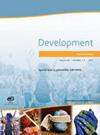KDM6B is a conserved activator at the top of the male sex determination pathway.
IF 3.7
2区 生物学
Q1 DEVELOPMENTAL BIOLOGY
引用次数: 0
Abstract
In mammals, commitment to the testis fate is controlled by the gene Sry on the Y chromosome; however, how Sry is regulated is not well understood. In the red-eared slider turtle, Dmrt1 acts as the primary activator of the testis pathway. Removal of the repressive histone modification H3K27me3 from Dmrt1 by the histone demethylase KDM6B is required for its activation. We hypothesized that a similar de-repression mechanism is used in mammals to activate the testis pathway. Using a mouse knockout model for Kdm6b, we found that loss of Kdm6b leads to a delay in Sry activation and the development of an ovotestis. These results implicate KDM6B as a conserved regulator at the top of the sex determination cascade in both reptiles and mammals.
KDM6B是一个保守的激活因子,位于雄性性别决定通路的顶端。
在哺乳动物中,对睾丸命运的承诺由Y染色体上的Sry基因控制;然而,Sry是如何被调控的还不是很清楚。在红耳滑龟中,Dmrt1是睾丸通路的主要激活因子。通过组蛋白去甲基化酶KDM6B从Dmrt1中去除抑制组蛋白修饰H3K27me3是其激活所必需的。我们假设在哺乳动物中使用了类似的去抑制机制来激活睾丸通路。使用小鼠Kdm6b敲除模型,我们发现Kdm6b的缺失导致Sry激活和卵睾丸发育的延迟。这些结果暗示KDM6B在爬行动物和哺乳动物的性别决定级联中都是一个保守的调节器。
本文章由计算机程序翻译,如有差异,请以英文原文为准。
求助全文
约1分钟内获得全文
求助全文
来源期刊

Development
生物-发育生物学
CiteScore
6.70
自引率
4.30%
发文量
433
审稿时长
3 months
期刊介绍:
Development’s scope covers all aspects of plant and animal development, including stem cell biology and regeneration. The single most important criterion for acceptance in Development is scientific excellence. Research papers (articles and reports) should therefore pose and test a significant hypothesis or address a significant question, and should provide novel perspectives that advance our understanding of development. We also encourage submission of papers that use computational methods or mathematical models to obtain significant new insights into developmental biology topics. Manuscripts that are descriptive in nature will be considered only when they lay important groundwork for a field and/or provide novel resources for understanding developmental processes of broad interest to the community.
Development includes a Techniques and Resources section for the publication of new methods, datasets, and other types of resources. Papers describing new techniques should include a proof-of-principle demonstration that the technique is valuable to the developmental biology community; they need not include in-depth follow-up analysis. The technique must be described in sufficient detail to be easily replicated by other investigators. Development will also consider protocol-type papers of exceptional interest to the community. We welcome submission of Resource papers, for example those reporting new databases, systems-level datasets, or genetic resources of major value to the developmental biology community. For all papers, the data or resource described must be made available to the community with minimal restrictions upon publication.
To aid navigability, Development has dedicated sections of the journal to stem cells & regeneration and to human development. The criteria for acceptance into these sections is identical to those outlined above. Authors and editors are encouraged to nominate appropriate manuscripts for inclusion in one of these sections.
 求助内容:
求助内容: 应助结果提醒方式:
应助结果提醒方式:


